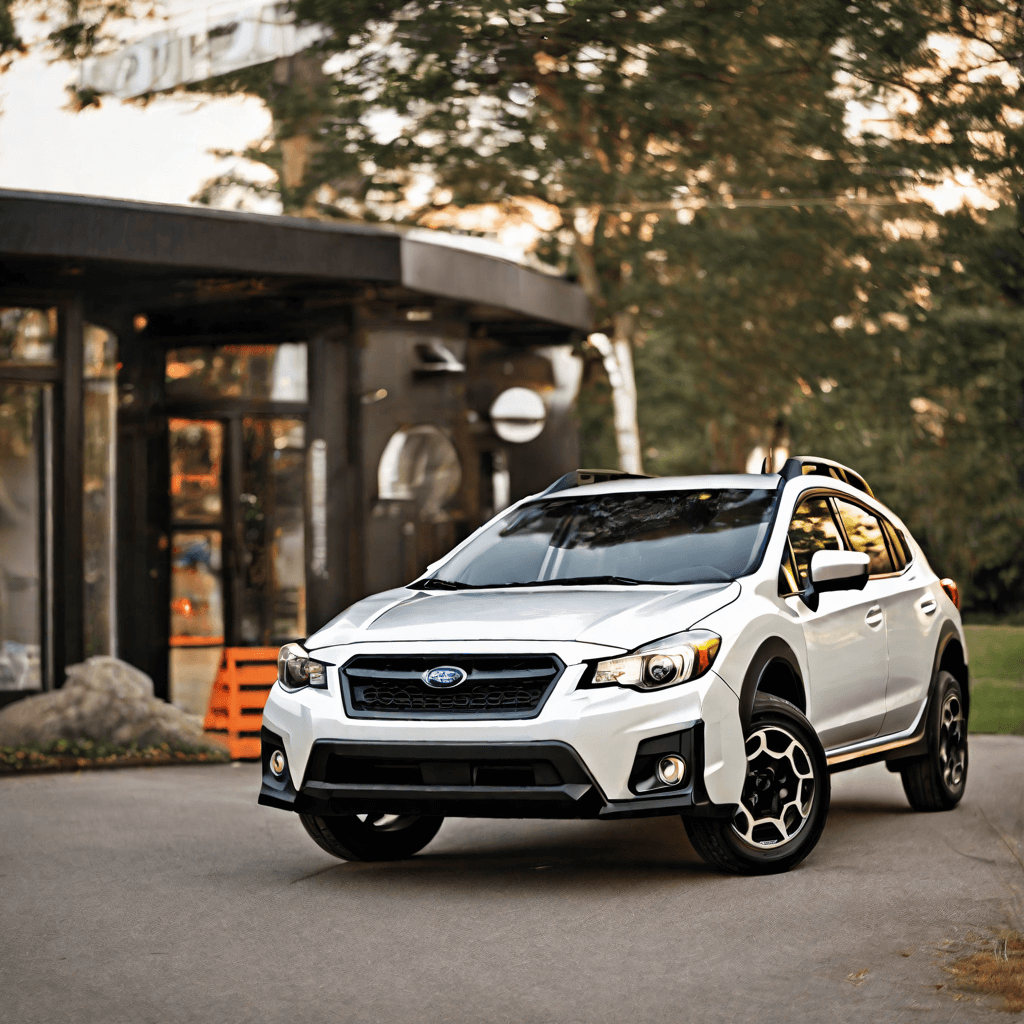Introduction to Subaru Crosstrek Tire Pressure
When it comes to taking care of your Subaru Crosstrek, one thing that you might forget about is checking the air pressure in your tires. This might not seem like a big deal, but it’s actually really important for a few reasons.
Why is tire pressure important for your Subaru Crosstrek?
Having the right amount of air in your tires matters because:
- Better gas mileage: When your tires are at the correct pressure, it helps your car use less fuel. If they’re not inflated enough, it can make your engine work harder and burn more gas.
- Longer-lasting tires: If your tires don’t have enough air in them, it can make them wear out faster and unevenly. That means you’ll have to replace them sooner, which can be expensive.
- Safer driving: The right tire pressure helps you have good control over your car. If your tires are too low on air, it can make them harder to handle and increase the chances of having an accident.
What happens if your tire pressure is wrong?
Not paying attention to your tire pressure can cause some problems:
- Less traction: When your tires don’t have enough air, it reduces how much of the tire touches the road. This can make it harder for your car to grip the road, especially when it’s wet or slippery. That means it’ll take longer for you to stop and you might slide around more.
- Tire blowouts: On the other hand, if there’s too much air in your tires, it puts extra strain on them. This can make them more likely to burst while you’re driving, especially if you’re going fast. A blowout can be really dangerous because it can cause you to lose control of your car.
- Worse braking: Having the wrong tire pressure can also affect how well your brakes work, especially in an emergency. If your tires don’t have enough air, it can take longer for you to come to a stop. That means you might not be able to avoid a collision in time.
To make sure that your Subaru Crosstrek is running its best and you’re safe on the road, it’s important to know what the right tire pressure is for your car. Let’s find out how to find this information in the next section.


Understanding Recommended Tire Pressures for Subaru Crosstrek
When it comes to taking care of your Subaru Crosstrek and making sure it performs well on the road, one thing you shouldn’t overlook is tire pressure. Having the right tire pressure is important for a few reasons:
- Better Handling: When your tires are properly inflated, it improves how your car handles. This means you’ll have better control over your vehicle, especially when making turns or sudden maneuvers.
- Improved Fuel Efficiency: Correct tire pressure helps reduce rolling resistance, which means your engine doesn’t have to work as hard to move the car forward. As a result, you may notice better gas mileage and savings at the pump.
- Enhanced Safety: Adequate tire pressure ensures that your tires have good contact with the road surface. This allows them to grip the road better, especially in wet or slippery conditions, reducing the risk of accidents.
Now that we understand why tire pressure is crucial, let’s find out how to determine the recommended tire pressures for your Subaru Crosstrek and keep track of them effectively.
Finding the Recommended Tire Pressures for Subaru Crosstrek
To find out what tire pressures are recommended for your specific Subaru Crosstrek model, there are a couple of reliable methods you can use:
- Check the Owner’s Manual
- Your Subaru Crosstrek’s owner’s manual is a valuable resource that contains detailed information about tire maintenance, including the recommended tire pressures. It’s important to refer to your owner’s manual to find out the exact numbers that are suitable for your particular Subaru Crosstrek model. These recommendations take into account factors such as:
- The weight of your vehicle
- The size of your tires
- How you plan to use your car (e.g., city driving, off-roading)
- By following these guidelines, you’ll be able to set the right tire pressures that are tailored to your Subaru Crosstrek’s specifications.
- Use the Driver Information Display
- Many modern vehicles, including the Subaru Crosstrek, come with a driver information display that allows you to keep an eye on various aspects of your car’s performance. This display usually includes a tire pressure monitoring system (TPMS), which gives you real-time updates on your tire pressures. By going through the display menu options, you can easily find and verify the recommended tire pressures specific to your Subaru Crosstrek.
- Note: If your Subaru Crosstrek is equipped with TPMS, it’s still recommended to manually check your tire pressures regularly using a tire pressure gauge, as TPMS may not always provide precise readings.
Remember, it’s not just about finding the right numbers when it comes to maintaining proper tire pressure. There are other factors to consider as well. In the next section, we’ll explore some tips for keeping your tire pressure in check.


Tips for Maintaining Proper Tire Pressure
Proper tire pressure is crucial for the performance and safety of your Subaru Crosstrek. Following the manufacturer’s recommended tire pressures is essential to ensure optimal driving experience and longevity of your tires. Here are some tips to help you maintain the correct tire pressure:
1. Using a tire gauge to check tire pressure
Regularly checking your tire pressure with a reliable tire gauge is important. This simple tool allows you to measure the air pressure inside each tire accurately. It’s recommended to check the tire pressure at least once a month or before long trips.
2. How to properly inflate or deflate tires using an air pump
If your tires are underinflated, it’s crucial to add air to reach the recommended pressure. On the other hand, if they’re overinflated, you’ll need to release some air until they reach the correct PSI (pounds per square inch). An air pump with a built-in pressure gauge can be a handy tool for this task.
- When inflating, connect the air pump nozzle securely to the valve stem and add air in short bursts while periodically checking the pressure with a gauge.
- To deflate, gently press the center pin in the valve stem with a small tool or your fingernail until you hear a hissing sound. Continue until you reach the desired pressure.
3. Regularly checking and adjusting tire pressure
Tire pressure can fluctuate due to changes in temperature and normal wear over time. It’s important to make it a habit to check your Subaru Crosstrek’s tire pressure regularly. By maintaining proper inflation levels, you can improve fuel efficiency, extend tire life, and enhance overall vehicle performance.
Remember that both overinflated and underinflated tires can have adverse effects on your vehicle:
- Overinflated tires may cause a harsh ride, reduced traction, and uneven wear in the center of the tread.
- Underinflated tires can lead to decreased fuel efficiency, poor handling, increased braking distance, and excessive wear on the outer edges of the tread.
By following these tips and keeping a close eye on your Subaru Crosstrek’s tire pressure, you can ensure a smooth and safe driving experience. Regular tire maintenance is essential for optimal performance and longevity of your tires.
Subaru Crosstrek Tire Pressure Light and Monitoring System
Proper tire pressure is crucial for the performance and safety of your Subaru Crosstrek. To help you monitor and maintain the right tire pressure, Subaru has equipped the Crosstrek with a tire pressure monitoring system (TPMS) and a tire pressure warning light. In this section, we will delve into understanding this system, interpreting the warning light, and even how to change the Subaru tire pressure monitor from KPA to PSI.
Understanding the Subaru Crosstrek Tire Pressure Monitoring System
The TPMS in your Subaru Crosstrek is designed to monitor the air pressure in your tires. It consists of sensors located inside each tire that transmit real-time data to the car’s computer system. The system continuously monitors the tire pressures and alerts you if there is a significant deviation from the recommended levels.
Interpreting the Tire Pressure Warning Light
When the tire pressure in any of your Crosstrek’s tires drops below the recommended level, the TPMS will trigger the tire pressure warning light on your dashboard. This warning light typically appears as an exclamation mark inside a horseshoe-shaped symbol or as an image of a tire with an exclamation mark.
When you see this warning light, it’s important not to ignore it. It indicates that one or more of your tires have low pressure, which can affect your vehicle’s handling, and fuel efficiency, and even lead to tire damage or blowouts. When this light illuminates, it’s crucial to check your tire pressures promptly and adjust them accordingly.
Changing the Subaru Tire Pressure Monitor from KPA to PSI
By default, Subarus display tire pressure readings in kilopascals (KPA), which is a common unit used internationally. However, if you prefer to see your tire pressures in pounds per square inch (PSI), you can easily change this setting on your Crosstrek’s driver information display. Here’s how:
- Start by turning on your Crosstrek’s ignition without starting the engine.
- Locate the “INFO” button on your steering wheel and press it until you see “SETTINGS” displayed on the driver information display.
- Use the arrow buttons to navigate to “UNIT” and press the “INFO” button to select it.
- On the next screen, choose “PRESSURE UNIT” and press the “INFO” button again.
- You can now select either “KPA” or “PSI.” Highlight your preferred unit and press the “INFO” button once more to confirm your choice.
Changing the tire pressure monitor from KPA to PSI gives you the convenience of seeing pressure readings in a unit that you are more familiar with.
Understanding the Subaru Crosstrek tire pressure monitoring system, interpreting the warning light, and changing the pressure monitor unit from KPA to PSI are essential aspects of maintaining proper tire pressure. By being attentive to these indicators and promptly addressing any issues, you can ensure optimal performance and safety for your Subaru Crosstrek.


Tire Replacement and Maintenance for Subaru Crosstrek
When it comes to taking care of your Subaru Crosstrek, tire maintenance is important. Not only does it make your ride smoother and safer, but it also helps your tires last longer. In this section, we’ll talk about how to tell if your tires are worn out or damaged, and when you should think about getting new ones.
Signs of Worn-Out or Damaged Tires
Regularly checking your tires for signs of wear and damage is crucial for staying safe on the road. Here are some things to look out for that might mean it’s time to replace your Subaru Crosstrek tires:
- Tread wear indicators: Tires have special markers called “wear bars” that show when the tread is getting too low. These bars are across the grooves in the tire, and when they become even with the surface of the tread, it means the tire has reached its minimum safe depth. If you see these markers, it’s a clear sign that you need new tires.
- Cracks, bulges, or holes: Take a good look at your tires every now and then to see if there are any visible cracks in the side or bulges on the surface. These could be signs of internal damage or weak spots that might cause a blowout. Also, if you spot any holes in the tire, they can weaken it and should be fixed right away or replaced if necessary.
Remember, even if your tires still have enough tread depth left, these signs of damage mean you should take action right away and consider getting new ones.
When you’re checking for wear and damage on your tires, make sure to inspect all four of them because uneven wear or damage on just one tire could be a sign of alignment issues or problems with your suspension.
When to Get New Tires for Subaru Crosstrek
While checking your tires regularly can help you catch specific signs of wear and damage, there are some general guidelines to keep in mind when deciding if it’s time to replace your Subaru Crosstrek tires:
- Recommended mileage: Tires don’t last forever because of things like normal use and exposure to the weather. As a general rule, experts suggest getting new tires every 40,000 to 60,000 miles. But remember, this timeframe can vary depending on factors like how and where you drive and the quality of the tires.
- Comparison to other Subaru models: Different Subaru models might have different suggestions for what kind of tires to use based on how much they weigh and how they perform. It’s important to check your owner’s manual or ask a reliable Subaru dealer to make sure you’re following the right recommendations for your Crosstrek model.
Doing regular tire maintenance, like keeping them properly inflated and rotating them regularly, can help make them last longer. And if you notice any signs of wear or damage, dealing with them as soon as possible will help keep your tires working well and keep you safe.
Stay tuned for more useful information on taking care of your Subaru Crosstrek!
When is it Time to Replace Tires on a Subaru Crosstrek?
Proper tire maintenance is crucial for the optimal performance and safety of your Subaru Crosstrek. Knowing when to replace your tires is an important part of tire care. Here are some factors to consider:
1. Tread Wear
One of the key indicators that your tires need replacement is tread wear. As tires age and are used, the tread depth decreases, affecting traction and grip on the road. Keep an eye on the tread wear indicators located in the grooves of your tires. If the tread depth reaches 2/32 of an inch or less, it’s time to replace them.
2. Cracks, Bulges, or Punctures
Inspect your tires regularly for any visible signs of damage such as cracks, bulges, or punctures. These can compromise the structural integrity of the tire and increase the risk of a blowout. If you notice any of these issues, it’s best to replace the affected tire(s) promptly.
Recommended Mileage for Tire Replacement
When it comes to recommended mileage for tire replacement, it can vary depending on various factors such as driving conditions and habits. However, a general guideline is to replace your tires every 40,000 to 60,000 miles. Keep in mind that this is just an estimate, and it’s essential to assess the condition of your tires regularly.
Tire Pressure Requirements
In comparison to other recent generation Subaru models like the Forester, Outback, Impreza, Legacy, WRX, and BRZ, the Subaru Crosstrek has similar tire pressure requirements. However, it’s always recommended to consult your owner’s manual or contact a certified Subaru technician for specific tire pressure information related to your Crosstrek model.
Regularly monitoring and maintaining proper tire pressure ensures:
- A smoother ride
- Improved fuel efficiency
- Enhanced safety on the road
By understanding when to replace your tires and practicing proper tire maintenance, you can prolong the lifespan of your Subaru Crosstrek’s tires and enjoy a comfortable driving experience. Remember, your tires are the only point of contact between your vehicle and the road, so it’s crucial to prioritize their care and replacement when necessary.
Conclusion
Proper tire pressure is crucial for maintaining the optimal performance and safety of your Subaru Crosstrek. By following these tips and guidelines, you can ensure that your tires are always in top condition:
- Importance of maintaining proper tire pressure for Subaru Crosstrek
- Maintaining the recommended tire pressure not only improves fuel efficiency but also enhances traction, handling, and overall vehicle performance.
- It also reduces the risk of accidents caused by tire blowouts or poor handling.
- Tips for monitoring and maintaining tire pressure
- Regularly check your tire pressure using a reliable tire gauge and adjust it as needed.
- Utilize the driver information display in your Subaru Crosstrek to monitor tire pressure on the go.
- This will help you catch any deviations from the recommended levels promptly.
- Regular tire maintenance and replacement for optimal performance
- Keep an eye out for signs of worn-out or damaged tires, such as:
- Tread wear indicators
- Cracks
- Bulges
- Punctures
- Replace tires when necessary to ensure your Subaru Crosstrek continues to perform at its best.
Remember, proper tire pressure is a small but vital aspect of vehicle maintenance that can have a significant impact on your driving experience. By prioritizing regular checks and maintenance, you’ll not only enhance your safety but also extend the lifespan of your tires and improve overall fuel efficiency. Take care of your tires, and they’ll take care of you on the road.




